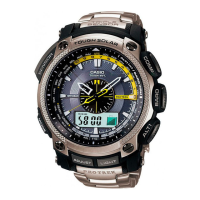E-1
ENGLISH
Congratulations upon your selection of this CASIO watch.
Applications
The built-in sensors of this watch measure direction, barometric pressure, temperature and altitude.
Measurement results are indicated by the second hand of the watch and on the digital display. Such
features make this watch useful when hiking, mountain climbing, or when engaging in other such outdoor
activities.
Warning !
• The measurement functions built into this watch are not intended for taking measurements that
require professional or industrial precision. Values produced by this watch should be considered
as reasonable representations only.
• When engaging in mountain climbing or other activities in which losing your way can create a
dangerous or life-threatening situation, always use a second compass to confi rm direction
readings.
• Note that CASIO COMPUTER CO., LTD. assumes no responsibility for any damage or loss
suffered by you or any third party arising through the use of this product or its malfunction.
Operation Guide 5113 5213
MO1103-EA
E-2
About This Manual
• Depending on the model of your watch, display text appears either as
dark fi gures on a light background, or light fi gures on a dark
background. All sample displays in this manual are shown using dark
fi gures on a light background.
• Button operations are indicated using the letters shown in the
illustration.
• Note that the product illustrations in this manual are intended for
reference only, and so the actual product may appear somewhat
different than depicted by an illustration.
(Light)
(Light)
(Light)
(Light)
E-3
Things to check before using the watch
1. Hold down
D
for about two seconds to enter the Timekeeping Mode, and then observe the
movement of the second hand.
Is the second hand moving smoothly at one-second intervals?
Go to step 2.
Power is low. Charge the watch by placing it in
a location where it is exposed to light. For
details, see “Charging the Watch” (page E-9).
NO
YES
YES
Is the second hand moving at two-second
intervals or is it stopped completely?
The watch is charged sufficiently. For details
about charging, see “Charging the Watch”
(page E-9).
NEXT
2. Check the Home City and the daylight saving time (DST) setting.
Use the procedure under “To confi gure Home City settings” (page E-20) to confi gure your Home City and
daylight saving time settings.
Important!
Proper World Time Mode data depends on a correct Home City selection, and time and date settings in
the Timekeeping Mode. Take care that these settings are confi gured correctly.
E-4
3. Set the current time.
See “Confi guring Current Time and Date Settings” (page E-22).
The watch is now ready for use.
E-5
Contents
E-2 About This Manual
E-3 Things to check before using the watch
E-9 Charging the Watch
E-14 To recover from the sleep state
E-15 Mode Reference Guide
E-19 Timekeeping
E-20 Confi guring Home City Settings
E-20 To confi gure Home City settings
E-21 To change the Daylight Saving Time (summer time) setting
E-22 Confi guring Current Time and Date Settings
E-22 To change the current time and date settings
E-25 Taking Direction Readings
E-25 To take a direction reading
E-28 To perform magnetic declination correction
E-29 To perform bidirectional calibration
E-30 To perform northerly calibration
E-31 To set a map and fi nd your current location
E-33 To fi nd the bearing to an objective
E-6
E-35 Taking Barometric Pressure and Temperature Readings
E-35 To enter and exit the Barometer/Thermometer Mode
E-36 To take barometric pressure and temperature readings
E-41 To calibrate the pressure sensor and the temperature sensor
E-43 Taking Altitude Readings
E-44 To take an altimeter reading
E-46 To select the altitude auto measurement method
E-50 To change the altitude differential scale step unit
E-50 To set the altitude differential start point
E-51 To use the altitude differential value
E-53 To specify a reference altitude value
E-54 To create a manual save record
E-60 Specifying Temperature, Barometric Pressure, and Altitude Units
E-60 To specify temperature, barometric pressure, and altitude units
E-62 Precautions Concerning Simultaneous Measurement of Altitude and Temperature
E-63 Viewing Altitude Records
E-63 To view altitude records
E-65 To delete a single altitude record
E-65 To delete all altitude records
E-7
E-66 Using the Stopwatch
E-66 To enter the Stopwatch Mode
E-66 To perform an elapsed time operation
E-66 To pause at a split time
E-67 To measure two fi nishes
E-68 Using the Countdown Timer
E-68 To enter the Countdown Timer Mode
E-68 To specify the countdown start time
E-69 To perform a countdown timer operation
E-69 To stop the alarm
E-70 Using the Alarm
E-70 To enter the Alarm Mode
E-71 To set an alarm time
E-72 To test the alarm
E-72 To turn an alarm and the Hourly Time Signal on and off
E-72 To stop the alarm
E-73 Checking the Current Time in a Different Time Zone
E-73 To enter the World Time Mode
E-73 To view the time in another time zone
E-74 To specify standard time or daylight saving time (DST) for a city
E-75 To swap your Home City and World Time City

